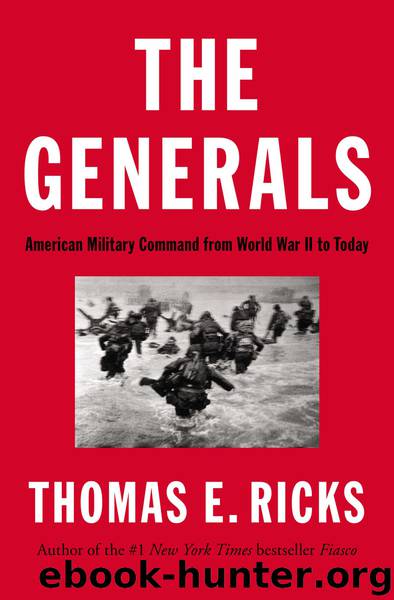The Generals by Thomas E. Ricks

Author:Thomas E. Ricks
Language: eng
Format: epub
Publisher: Penguin Publishing Group
Published: 2016-02-04T05:00:00+00:00
CHAPTER 21
The end of a war, the end of an Army
T he history of the Vietnam War is far more complex than what is rendered in popular culture. Even now, almost four decades after it ended, it is probably the least understood of America’s wars. No authoritative military history of the Vietnam War exists. There is no narrative that captures the ebb and flow of the war tactically and strategically, showing both battlefield actions and the deliberations of senior officials. Existing histories of the war give a taste of combat and thereafter tend to concentrate on the political and diplomatic discussions among senior American officials in Saigon and Washington.
The Vietnam War certainly was not one long, steady descent into a quagmire, as some books, films, and songs would have us believe. Rather, it was a series of complicated interactions between four major military forces: the South Vietnamese forces, the American military, the Viet Cong, and the North Vietnamese Army. By late 1968 and early 1969, each of those forces had been altered by its experience in the conflict. The Viet Cong had been decimated and demoralized by the Communist offensives in February and May of 1968, which also had brought to the surface the VC’s clandestine network in the South and shown its face to local officials, making it far more vulnerable. In 1965, Communist forces in the South were about three-quarters Viet Cong, while by 1970 they were about three-quarters North Vietnamese Army, according to a comment made by Gen. Creighton Abrams in the latter year. (However, some contemporary historians caution against accepting the notion that the Viet Cong had only a small role in the war after Tet, noting that it has been in the interests of the Hanoi government “to minimize the role of local forces in the conquest of South Vietnam.”) “By winter of 1969 the VC were just sort of running around like a bunch of chickens and it really was no contest,” said Lt. Gen. Julian Ewell, who commanded the 9th Infantry Division in the Mekong Delta in 1968 and then was promoted to lead a corps-level headquarters.
The conventional North Vietnamese Army moved in large numbers into the South, but the new Northern troops who replaced the Viet Cong were largely inexperienced. “The NVA were tenacious but not very successful against U.S. forces,” said Al Santoli, who served with the 25th Infantry Division in Vietnam in 1968–69. “They suffered needless mass casualties attempting frontal assaults on U.S. positions and, in most cases, where they used concealment of terrain for ambush, they were unable to sustain initiative beyond immediate surprise against U.S. infantry.” By the spring of 1970, military mail intercepted en route from North Vietnam “was pleading with the units and the party cadre not to get engaged in military ground action at all,” recalled Maj. Gen. Elvy Roberts, a veteran of the Battle of the Bulge who commanded the 1st Cavalry Division in 1969–70. “They realized they couldn’t sustain it. They were too weak.
Download
This site does not store any files on its server. We only index and link to content provided by other sites. Please contact the content providers to delete copyright contents if any and email us, we'll remove relevant links or contents immediately.
| Africa | Americas |
| Arctic & Antarctica | Asia |
| Australia & Oceania | Europe |
| Middle East | Russia |
| United States | World |
| Ancient Civilizations | Military |
| Historical Study & Educational Resources |
The Radium Girls by Kate Moore(11589)
100 Deadly Skills by Clint Emerson(4668)
The Templars by Dan Jones(4548)
Rise and Kill First by Ronen Bergman(4537)
The Doomsday Machine by Daniel Ellsberg(4234)
The Rape of Nanking by Iris Chang(4004)
Killing England by Bill O'Reilly(3891)
Hitler in Los Angeles by Steven J. Ross(3788)
Stalin by Stephen Kotkin(3710)
12 Strong by Doug Stanton(3407)
Hitler's Monsters by Eric Kurlander(3143)
Blood and Sand by Alex Von Tunzelmann(3041)
Darkest Hour by Anthony McCarten(3009)
The Code Book by Simon Singh(2839)
The Art of War Visualized by Jessica Hagy(2824)
Hitler's Flying Saucers: A Guide to German Flying Discs of the Second World War by Stevens Henry(2616)
Babylon's Ark by Lawrence Anthony(2421)
The Second World Wars by Victor Davis Hanson(2415)
Tobruk by Peter Fitzsimons(2368)
